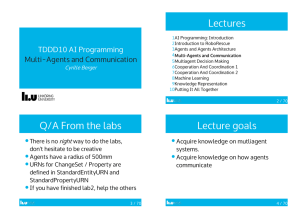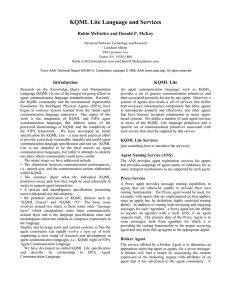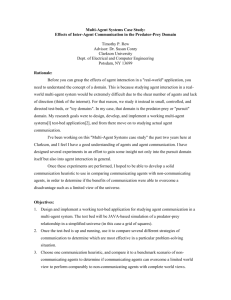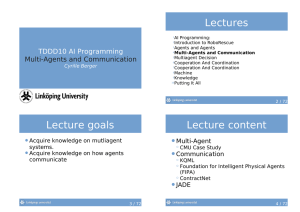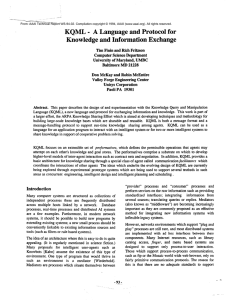The power of distributed software agents by Lance Dean Kind
advertisement
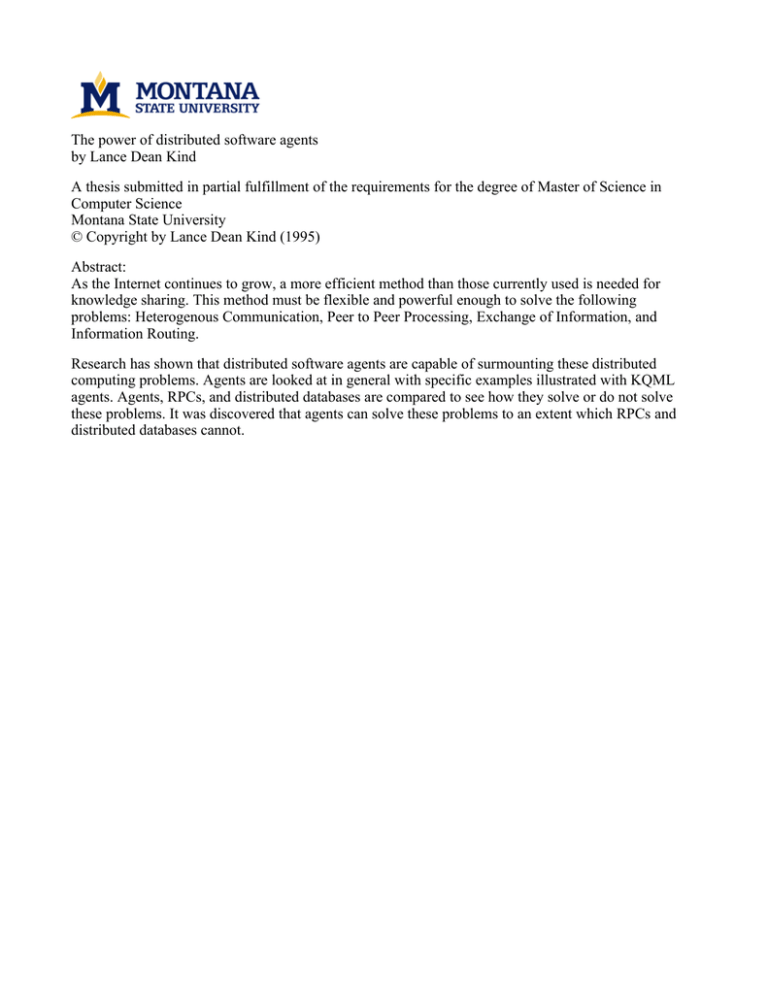
The power of distributed software agents
by Lance Dean Kind
A thesis submitted in partial fulfillment of the requirements for the degree of Master of Science in
Computer Science
Montana State University
© Copyright by Lance Dean Kind (1995)
Abstract:
As the Internet continues to grow, a more efficient method than those currently used is needed for
knowledge sharing. This method must be flexible and powerful enough to solve the following
problems: Heterogenous Communication, Peer to Peer Processing, Exchange of Information, and
Information Routing.
Research has shown that distributed software agents are capable of surmounting these distributed
computing problems. Agents are looked at in general with specific examples illustrated with KQML
agents. Agents, RPCs, and distributed databases are compared to see how they solve or do not solve
these problems. It was discovered that agents can solve these problems to an extent which RPCs and
distributed databases cannot. THE POW ER OF DISTRIBUTED SOFTW ARE AGENTS
by
Lance Dean Kind
A thesis submitted in partial fulfillment
of the requirements for the degree
of
Master of Science
in
Computer Science
MONTANA STATE UNIVERSITY
Bozeman, Montana
April 1995
© C O P Y R IG H T
by
Lance Dean Kind
1995
All Rights Reserved
Il
APPROVAL
of a thesis submitted by
Lance Dean Kind
This thesis has been read by each member of the thesis
committee and has been found to be satisfactory regarding content, English
usage, format, citations, bibliographic style, and consistency, and is ready for
submission to the College of Graduate Studies.
Approved for the Major Department
4 /W t
Date
Head, Major Department
\
Approved for the College of Graduate Studies
Date
Graduate Dean
iii
STATEM ENT OF PERMISSION TO USE
In presenting this thesis in partial fulfillment of the requirements for a
master’s degree at Montana State University, I agree that the Library shall make it
available to borrowers under rules of the Library.
If I have indicated my intention to copyright this thesis by including a
copyright notice page, copying is allowable only for scholarly purposes, consistent
with "fair use" as prescribed in the U.S. Copyright Law. Requests for permission
for extended quotation from or reproduction of this thesis in whole or in parts may
be granted only by the copyright holder.
Signature - oLrum
D ate ___
4
l
3
-? .< —
TABLE OF CONTENTS
Page
1. IN TR O D U CTIO N ..............................................................................................
I
W hat is an Agent?............................................................................................
2
2. HETEROGENOUS CO M M UNICATIO N............................................................. 4
■Si- LO N h - CO
Agent Communication
KQML.......................
Other Methods of Distributed Computing
RPCs........................................................
Distributed Databases..........................
3. PEER TO PEER P R O C ESSIN G ....................................................................
9
KQML Agents..,.................................................................................................
12
4. EXCHANGE OF INFORM ATION.......... ........................................................
14
KQML..................................................................................................................
Shop-Talk......................................................................................................
Agentifying Current Software.................................................................
K IF..................................................................................................................
Ontology..........................
Other Methods of Distributed Computing......................................................
R PC .................................
Distributed Databases.................................................................................
14
16
18
20
20
21
21
22
5. INFORMATION R O U TIN G ............................................................................... 23
Agent Name Servers........................................................................................
Content Based Routing.....................................................................................
Facilitators............................................................................................................
Federation......... ..................................................................................................
R PC .....................................................................................................
6. SU M M AR Y............................................................................
23
25
25
26
27
29
R EFER EN C ES......................................................................................................... 30
LIST OF TABLES
Table
1.
2.
3.
4.
5.
6.
Page
KQML String Syntax in EBNF........................................................................ 5
Implemented KQML Performatives............................................................... 6
Fred’s Agent Requesting Information on Roofing Nails......................... 12
Form of a KQML Performative.....................................................................14
EBNF Form of Shop-Talk’s Syntax.............................................................16
Pseudocode and EBNF of Shop-Talk Returned Values........................ 17
vi
LIST OF FIGURES
Figure
1.
2.
3.
4.
5.
6.
7.
8.
Page
Client Server Paradigm................................................................................ 9
Peer to Peer Process Communication....................................................... 10
Transducer Agent............................................................................................18
Wrapper Agent................................................................................................. 19
ANS Hierarchy............................................................................................... 24
Facilitators and Agents in a Federation......................
26
RPC Location Broker Routing Scheme...................................................... 27
Agent n Uses Multiple Routing Schemes...................................................28
vii
ABSTRACT
As the Internet continues to grow, a more efficient method than those
currently used is needed for knowledge sharing. This method must be flexible
and powerful enough to solve the following problems:
Heterogenous Communication,
Peer to Peer Processing,
Exchange of Information, and
Information Routing.
Research has shown that distributed software agents are capable of
surmounting these distributed computing problems. Agents are looked at in
general with specific examples illustrated with KQML agents. Agents, RPCs, and
distributed databases are compared to see how they solve or do not solve these
problems. It was discovered that agents can solve these problems to an extent
which RPCs and distributed databases cannot.
1
CHAPTER 1 INTRODUCTION
With the increased popularity of the Internet, organizations have been
trying to find effective ways to communicate between different sites worldwide. At
this time information is being disseminated through the network but not always in
a user friendly manner; the user must often learn to use cryptic software like ftp
and telnet. What is needed is some common method of sharing knowledge
which can take advantage of network structures.. This common method must be
flexible enough and robust enough to surmount the following problems:
1) Heterogenous Communication: This is due to the fact that there are a
wide variety of platforms and operating systems in operation on
the Internet.
2) Peer to Peer Processing: The client server paradigm
is limiting in cases where asynchronous transactions are an
advantage.
3) Exchange of Information: Flexibility is
needed so that all types of information can be represented and shared.
4) Information Routing: Routing is an important and often overlooked
problem; if one cannot find the pertinent information, then the
information is as good as useless.
2
Research has shown that not only can distributed software agents solve
these problems; but they often do it better than other methods of distributed
computing such as RPCs and distributed databases.
What is an Agent?
Three definitions of an agent supplied by a wordprocessor (Excellence!)
are:
1) one by which work is accomplished or an end effected;
2) one who acts for another; and
3) one who keeps secret watch to obtain information.
The first two definitions are the spirit of why one would want to have a
software agent. The last one could be facilitated by a software agent, but is
unethical.
3
M. Genesereth and S. Ketchpel define a software agent as:
4) "software ’components’ that communicate with their peers by
exchanging messages in an expressive agent communication
language." [4]
This definition implies that not only should an agent be able to perform
definitions one through three, an agent should communicate with other software
agents. All four of these definitions imply a behavioral condition for agenthood;
i.e. if a piece of software exchanges messages in an agent communication
language then it is an agent.
Discussions about how agents can solve the four problems brought up in
the introduction will be organized in the following manner: CHAPTER 2
HETERO G ENO US COMMUNICATION; CHAPTER 3 PEER TO PEER
PROCESSING; CHAPTER 4 EXCHANGE OF INFORMATION; and CHAPTER 5
INFORMATION ROUTING.
4
CHAPTER 2 HETEROGENOUS COMMUNICATION
If effortless information sharing is to be achieved, heterogenous
communication is a requirement. A solution should be able to support multiple
protocols including: TCP/IP, SMTP, and HTTP since these are the most prolific
protocols running on the Internet.
Agent Communication
Agents can use many different communication protocols to connect to
the Internet. KAPI (KQML Application Interface) was chosen for implementing
KQML (Knowledge Query Manipulation Language) software agents, for this
thesis work, due to the wealth of communication protocols it supports [15]. Being
able to support many of these low level transport protocols is only part of the
problem. In order for different agents to have the ability to talk to each other
across different low level transport protocols, a common high level protocol is
needed. This high level protocol is called the agent communication language
(ACL). Different agents need to have a common ACL to allow interagent
communication. KQML, one such ACL, has been used in a variety of projects
funded by DARPA, the Air Force, and the Navy. (See Reference section).
Because of KQMUs flexibility and popularity, KQML agents were implemented for
the research shown in this thesis.
5
KQML
KQML is a speech act based ACL; the KQML transport was built to model
human speech [3]. KQML messages are performatives which contain keywords
and their expressions [ 1 , 2 , 6 , 11,13]. See Table I . (A detailed discussion on
Table 1
KQ m l String Syntax in EBNF
<performative> ::= (<performative_name> {<whitespace> :<keyword>
<whitespace> <expression>}*)
<performative_name> ::= <word>
<keyword> ::= <word>
<expression> ::= <word> | <quotation> | <string> |
({<word> {<whitespace> <expression>}*} | <performative> )
<word> ::= <character><character>*
KQML syntax and semantics is given in [I])
The KQML specification states that it is not a requirement to implement all
41 of the performatives listed in order to be KQML compliant.
In fact,
implementors may create more performatives for their own purposes if they find
the reserved KQML performatives lacking. The performatives mentioned in the
specification are reserved; if used, they must follow the specification requirements
in order to be KQML compliant. Each performative has keywords which have
certain values stored in their expression field as defined in the KQML
specification [1],
Experimental agent implementations for this thesis work consist of two
agents: one agent acts as a server which performs lookups in a database of
merchandise (a catalog) of some fictional business; the other agent acts as a
6
client which accepts input from a user who is interested in searching and pricing
some item. Table 2 shows five KQML performatives which were implemented; S
T a b l© 2
Implemented KQML Performatives
perform ative name> ::=asknf | ask-about |tell | deny |
error
Performative Name
Meaning
ask-if
S wants to know if the sentence is in
R’s VKB
ask-about
S want all relevant sentences in R’s
VKB
tell
the sentence in S’s VKB
deny
the embedded performative does not
apply to S
error
S considers R’s earlier message to
be malformed.
is the sending agent and R is the receiving agent. As requests for item
descriptions, and prices of items are sent to the merchandising agent (MAG), it
performs operations upon its catalog (database) and returns a performative (tell,
or deny) which reflects what the MAG has discovered in its database ( D B ) .
7
Other Methods of Distributed Computing
Agents compare favorably to other ways of creating distributed
applications. The pros and cons are discussed below.
RPCs
RPCs support only one transport mechanism: TCP/IP. This is only a slight
disadvantage since most machines, which are capable of network access, have
TCP/IP. The primary disadvantage is that different vendors have their own
systems of implementing RPCs. If an application is written using Sun RPCs, a
DCE RPC application will not be able to communicate with it. This is because
RPCs operate on a lower level than agents; binary data is marshaled into a form
for transport, and then delivered to the network, and then to the remote machine.
The marshaled form (called an interface definition language or IDL) is different
between RPC standards.
RPCs are implementation dependent while KQML does not try to force a
specific implementation. KQML is concerned with interagent communication; not
with data representation or transport. However, since RPCs are closer to the
hardware and operate on a level closer to the transport protocol, they typically
have higher performance for applications where computational speed is
important.
8
Unlike RPC ’s, agents are often machine and operating system
independent. Additionally, KQML is ASCII based so architectural characteristics
(like big endian versus little endian) are not significant and no data marshalling is
needed. The drawback to ASCII representation is that data is likely to require
more space and network bandwidth than a binary.
Distributed Databases
Distributed databases (DDB) allow data to be searched and retrieved from
remote sites. Portions of the DB may be physically stored at different sites to
allow load sharing. Some DDB use RPCs to perform operations on data.
However much like RPCs, each DDB implementation only communicates with
DDB of the same implementation. Different DDBs may be able to share data
after some type of conversion process is applied.
9
CHAPTER 3 PEER TO PEER PROCESSING
The client server model is the predominate model of software interaction
on the Internet. Figure 1 illustrates the client server paradigm. The client makes
F ig u r e
1 Client Server Paradigm
I reply
a request and the server responds by sending a reply in fulfillment of the request.
The communication is synchronous in nature since the communication takes
place in a lockstep fashion. The server never acts independently from a client.
This model is too restrictive if the server must be proactive. For example: If the
10
server in Figure 1 was a MAG, the owner could benefit if it could actively search
out new clients. If peer to peer processing were allowed, the MAG could
communicate with other agents which represent their owner’s interests. The
MAG could leave its address and a message as a "calling card". Later if the
owner of the agent is looking for an item, the agent could reference its DB of
agent addresses and interests; and contact the MAG for further information.
In peer to peer processing, one node may actively seek out a service like a
client, and later it may serve a request like a server. Figure 2 illustrates this
concept. With asynchronous communication, the replies are received in a
nondeterministic fashion. Each node does not know when a reply or a request
F ig u r e 2
Peer to Peer Process Communication
11
will arrive. The extra work involved in peer to peer as opposed to client server is
that the nodes have to keep track what reply went with which request. This extra
bookkeeping isn’t needed in client server since transactions occur in lockstep.
When an agent receives a message and decides that it is valid, it
executes the command or program which is embedded in the message. In this
fashion, a client agent’s program or command is executed in the server agent’s
address space. If there are return values, they are returned back to the client
agent.
12
KQML Agents
The KQML ACL supports peer to peer bookkeeping through keywords
which are imbedded in the performatives. Table 3 shows an example of an
agent’s request and the response received from the serving agent. This example
T a b lG 3
Fred’s Agent Requesting Information on Roofing Nails
Fred’s Agent
Request:
Response Received:
(ask-if
(tell
)
!receiver joeshardw are
!receiver fred
!sender fred
!sender joes hardware
!language shop-talk
!language shop-talk
!ontology shop-talk
!ontology shop-talk
:reply-with (nails 3-35-95, 3:00 PM)
:in-reply-to (nails 3-35-95, 3:00 PM)
!content (find (roofing nails))
!content ({(124,roofing nails)})
)
13
was generated with a MAG and a shopping agent; the scenario is as follows:
Fred is looking for roofing nails. He starts up his agent and asks it to
search Joes Hardware to see if it carries roofing nails. Notice the keyword replywith and its expression in Fred’s request. In the tell performative which Fred’s
agent received as a server, the in-reply-to keyword has the same expression as
the reply-with expression. This allows the agent to collate the messages it
receives by context; which is defined by the reply-with, in-reply-to, and sender
expressions. Notice that the date and the time are included in the context. This
is so that if multiple queries are made to Joes Hardware’s agent, the response’s
true context will be known. One more improvement that could be made is to add
a random number into the :reply-with <expression>. This would allow the context
to be understood unambiguously in case Fred’s agent can send out more than
one request per second. Since Joes Hardware’s agent did not put a reply-with
keyword in its performative, it is not expecting a reply.
Agents collecting information for their owners may send out dozens of
requests to other agents. Instead of waiting for each response as in the client
server situation, they may continue with other tasks. While doing other tasks, the
agents may receive responses concurrently. The agents will organize the
information they receive by context in their DB and output reports to the owners
as they make progress.
14
CHAPTER 4 EXCHANGE OF INFORMATION
The ability to exchange any information (that can be represented in a
computer) is the ability to represent all types of information: binary, ASCII,
extended ASCII, and knowledge itself.
KQML
KQML speaking agents have the ability to exchange all forms of data
because KQML does not care what is stored in the content expression. See
Table 4. W hat is placed in the content expression is up to the implementor; it
could be binary, ASCII, source code of a program,., etc. KQML is used by agents
Table 4
Form of a KQML Performative
(<performative_name>
receiver <expression>
:sender <expression>
!language <expression>
!ontology <expression>
:reply-with <expression>
!content <expression>
)
15
to talk to each other about data stored in the content expression.
The receiving agent discovers what is in the content expression by looking
at the language field. This field describes the language of the content field.
Notice that even though a given set of agents may be able to communicate due
to a common ACL, they may not be able to understand the data in the content
expression. They can communicate with each other about the data but they need
not understand the data.
For example, if agent 99 wants to exchange a lisp program with agent 007
(a prolog executing agent), 007 is going to get the lisp program and look at the
language field and see that it is not prolog. If 007 is a sophisticated agent, then it
could recruit the help of another agent to run the lisp program and then receive
the output from the lisp running agent. If 007 isn’t smart enough to do this or 007
can’t find a lisp executing agent, then 007 will have to respond with an error
performative; its comment expression could contain a plea of ignorance about the
sender’s language.
16
Shop-Talk
The MAG agent and the potential client agent must speak a
language/protocol called shop-talk. Table 5 describes the shop-talk language in
Table 5
EBNF Form of Shop-Talk’s Syntax
<shop-talk function> ::= (<command>)
<command> ::= ^description command> (<string>)} |
{<catalog command> (<catalog number>)}
<description command> ::= find
ccatalog command> ::= price | describe
<string> ::= {cupper or lower alpha char> [ <number> |
call punctuation except: \, (,). {,}, and ",">}+
ccatalog number> ::= call integers>
EBNF. The shop-talk language expresses queries to a MAG about its catalog.
One could use the find command to search an online catalog for some item which
is described in the cstring> field. Once the catalog number was found, the price
or the entire description of the item could be requested. The <string> definition
was restricted to make parsing the content expression easy.
Table 6 shows the form of the returned data; the MAG replies to shop-talk
Tabl©
6
Pseudocode and EBNF of Shop-Talk Returned Values
<shop talk fct output> : : = <ordered pair> {,cordered pair>}*"}"
<ordered pair> ::= (ccatalog number>,<data>)
if <shop talk fct output> is find | describe
<data> ::= <description>
else
<data> ::= <real number>
functions by returning a set. The set contains ordered pairs; the left part of the
pair is always a catalog number so that describe and price would be one to one
functions. The number of ordered pairs returned is determined by the context of
the KQML performative: if the performative name was ask-if, then the first match
would return; or if the performative name was ask-about, then all the matches
which exist in the receiver’s DB would return. Other KQML speaking agents can
talk to a MAG agent but only those that understand shop-talk can query the
catalog.
18
Aaentifvina Current Software
The value of having distributed access to data is obvious, but it is unlikely
that people will want to rewrite the software they are using. However, since
agenthood is defined by how a software component acts, software need only to
speak in an ACL to become an agent. The following paragraphs discuss some
techniques which allow legacy software to be made into agents.
Software for which there isn’t any access to the source code can be
agentified by writing a transducer agent [3]. The transducer agent accepts
messages from other agents and translates the messages into a form which is
acceptable to the software and then executes the software on the input. See
Figure 3. The agent then captures the software’s response and packages it into
F ig u r e
3 Transducer Agent
19
an ACL which is sent to the client agent. In KQML the response would be stored
in the content expression.
A wrapper agent is more efficient than a transducer agent; however the
source code to the software must be available [3]. See Figure 4. Code is added
F ig u r e 4
Wrapper Agent
to the software to extract data from an ACL message. This is more efficient due
to less serial communication than between an autonomous transducer agent and
its software package. The data structures which the program understands can be
implemented directly by the wrapper agent. The agent is not autonomous from
20
the software since it is part of the software’s code. Genesereth and Ketchpel
mention that a complete rewrite of the software could be done but they
acknowledge that this method is drastic [3].
KIF
KIF (Knowledge Interchange Format) is a popular content language used
with KQML [5 ,13 ,14 ]. KIF was developed for the purpose of allowing
interchange of knowledge between different computer programs. KIF is able to
do this because it is a formal language which allows one to express knowledge
about knowledge using predicate calculus [5]. Applications of KIF agents are
typically in the realm of artificial intelligence (Al).
Ontology
Agents which have a common ACL and can speak the same language
need to share an ontology for effective agent interaction [11]. Agents that speak
the same ACL and understand the same language may not be able to effectively
communicate. For example, I can speak English but I am still not able to
understand a quantum physics lecture. This is because I don’t understand the
jargon, units used, and how this knowledge relates. If someone gave me a sheet
of paper which defined the jargon, and the units, then I could follow the lecture;
the sheet of paper is called an ontology.
21
An ontology is a set of concepts and relations. For example: an ontology
about hierarchy could define the relationships between siblings, parents, and
children. The keyword, ontology, is used in some KQML performatives. (See
Table 4.) A salient feature of ontologies is that if a KQML/KIF agent encounters
an ontology which it doesn’t know, it can have the other agent send the ontology
(in KIF language) to it so that it can be added to its virtual knowledge base.
Ontologies are an important Al construct, since they allow communication of
concepts as well as data. The MAG agent defined the ontology as shop-talk (see
Table 3) but it is not needed since the shop-talk language consists of commands
which directly call functions, not a language in which functions are defined (like
KIF).
Other Methods of Distributed Computing
RPC
RPCs can represent most forms of knowledge but only in low level data
forms. Consequently, RPCs cannot exchange data with different
implementations due to the lack of a standard IDL. A set of agents may have the
same problem if they don’t understand the same content language. However, it
is possible for agents to route the content information (through the use of a
common ACL) to another agent which can act as a translator.
Another drawback to RPCs is that they have only been implemented in
procedural languages. Agents can have any language in its content field and the
receiver can execute the language if it understands the content language.
22
Agents can simulate RPCs by passing remote procedures (or procedure
calls) to procedure executing agents. RPCs can also be made into agents by
creating a transducer agent or a wrapper agent for the RPC program.
Distributed Databases
Since most DDBs are proprietary, they do not readily communicate with
other programs. To make a DDB more accessible, a transducer or wrapper agent
could be created. The advantage is that the owner of a DDB does not have to
reconstruct his DB files or buy a new program.
23
CHAPTER 5 INFORMATION ROUTING
The routing of information is a critical issue in distributing information
among several nodes. If the agent or RPC cannot find services to use, then they
are of little benefit. There are currently several ways to route agents to
information or route information to agents. Typical agent routing architectures
are: Agent Name Servers, Content Based Routing, Facilitators, and Federations.
Agent Name Servers
Agent name servers (ANS) are other agents that can be consulted by an
I
;
agent which is searching for information. ANS routing was used between the
MAGs and the agent shoppers; the NCSA HTTP daemon acted as a routing
agent due to KAPI’s support of HTTP as a transport [15]. URLs (uniform
resource locators) point to other agent resources (MAGs) on the network. A user
could ask an agent to find some information and give the agent a list of MAG
names to query; first the user’s agent would query a known ANS for URLs which
point to these MAGs. The ANS would return the URLs to the agent whereupon
j
:
24
the user’s agent could then route messages directly to the MAGs. A hierarchy of
ANSs could be setup like the Internet domain name servers. See Figure 5.
F i g u r e 5 ANS Hierarchy
ANS 3
ANS 2
ANS 1
agent.
agent
agent
.agent
If agent n is looking for an agent named y, it can consult its local ANS to
see if a URL points to an agent y. If y doesn’t exist, the ANS could use a URL
which points to another ANS on another node and forward agent n’s request.
This could continue on indefinitely so there would have to be some method of
bounding the number of ANS consulted and a cycle prevention scheme. The
25
drawback to ANS routing is that the client agent must know the name of the agent
to interact with.
Content Based Routing
If agent n doesn’t know other agents which can provide a service, it can
use a content base router agent (CBRA) to find suitable agents [12]. The content
based router agent maintains a DB on agents’ interests. A CBRA maintains this
DB by agents advertising their interests to it, or acquiring agent interests as they
use its services. CBRAs could also consult other CBRAs for information on
agents.
The disadvantage of CBRAs is that they must maintain a DB of known
agents. This could grow large as agent traffic increases. The advantage of
CBRAs is that an agent does not have to have prior knowledge of an agent name
which is required with the ANS architecture.
Facilitators
A facilitator is an agent like an ANS or a CBRA except it offers additional
services. If agent n uses a different content language than agent y, then the
facilitator could act as an interpreter between the two agents. There have been
other uses for facilitator agents such as acting as a subcontractor, translator,
m ediator,... etc. The roles of facilitators are constantly expanding [2, 6, 7 , 1 1 , 1 3 ,
14].
Facilitators can degrade agent performance. They may become a
bottleneck due to computationally expensive features such as translation.
26
Federation
A federation is a group of facilitators and agents arranged as shown in
Figure 6. The agents which are linked to a facilitator are dependent upon it for
F ig u r © 6
Facilitators and Agents in a Federation
tent;: !agent; ;agent
agent
A f
I
A
facilitator
facilitator
A
4
4
A
facilitator
4
A A A A A
y . Y . y.. Y _ T .
agent
fr g e rt;agent;
- J - Y - Y - Y - Y -
agent
agent
frgenit agent
agent
routing; the agents have given up their autonomy [7,13,14]. Agents provide
services to, or request services from the local facilitator; and the facilitator routes
agent’s messages to other agents or other facilitators in the federation hierarchy.
27
The advantages of a federation is that the agents are less complex
because they don't have to maintain information about routing. A disadvantage
would be that the agents are entirely dependent on the facilitator; so if a facilitator
fails, the dependent agents would be useless.
RPC
RPCs route their messages through location brokers. Location brokers
are like ANS in that they return to the program a list of servers (a lookup
operation) or just pick a server and call the remote procedure. Servers are
registered with the location brokers at run time. See Figure 7.
F ig u r e 7
Location brokers
RPC Location Broker Routing Scheme
servers register with
location broker
client consults
location broker
server table
server a
server b
location broker
RPC execute on server d
server d
28
can be set up in a hierarchy to facilitate routing. RPCs may obviate the need of a
location broker by explicitly naming the port.
RPCs do not allow dynamic routing like CBRA but they do allow routing of
RPCs without knowing a server’s name (unlike ANS). Agents support many more
routing options than RPCs. For example: Agent n could connect to a CBRA (by
knowing the CBRA’s URL) which will forward the message by its content to a
facilitator, which is part of a federation. The facilitator then routes the message to
one of its dependent agents. After the dependent agent is finished, it sends the
reply back to its facilitator which sends it back to the CBRA which in turn sends it
to agent n (using n’s URL which was in the sender expression). See Figure 8.
Figure 8
Agent n Uses Multiple Routing Schemes
r e q u e s t\
x reply
facilitator
request
agent n
CBRA
29
CHAPTER 6 SUMMARY
As shown in Chapters 1 through 4, agents can perform any function that
RPCs1 and DDBs can; and possibly more effectively. RPCs have an advantage
in execution speed due to the brevity in typical RPC communication. However:
1) agents can communicate over a larger variety of platforms/OSs than
RPCs;
2) agents are capable of peer to peer processing;
3) agents can carry data in any representation without remapping it to
an IDL; and
4) agents have more routing options.
A drawback to KQML agents is that KQML is open ended: implementators
are going to create new performatives which will not be supported by other
agents. This can also be an advantage because implementators can create
useful extensions to KQML. Agents which speak different ACLs are as
incompatible as different RPC implementations; so it will be important that one
common, standard ACL is selected if agents are to be widely used. Content
based routing or federations are important where transparent routing is a must.
However, CBRA and facilitators need more resources due to their complexity.
Agents will be very much a part of the future of the national information
infrastructure. However, it is hoped that a conglomeration of different ACL
standards is not used.
30
REFERENCES
[1] External Interfaces Working Group ARPA Knowledge Sharing Initiative.
Specification of the KQML agent communication language.
Draft/Working Paper, June 1993.
[2] Tim Finin, Richard Fritzson, Don McKay, and Robin McEntire. KQML as an
Agent communication Language. The Proceedings of the Third International
Conference on Information and Knowledge Management. ACM Press,
November 1994
[3] Yannis Labrou, Tim Finin. A semantics approach for KQML - a general
purpose communication language for software agents. Air Force Office of
Scientific Research under contract F49620-92-J-0174, and ARPA.
[4] Genesereth, M. R., and Ketchpel, S. Software Agents, Communications of
the ACM, Vol 37, no. 7, July 1994.
[5] Genesereth, M. R., Fikes, R. E. et al. Knowledge Interchange Format Version
3 Reference Manual, Draft, Logic-92-1, Stanford University Logic Group,
June 1992
[6] Tim Finin, Richard Fritzson, Don McKay, and Robin McEntire. KQML - A
Language and Protocol for Knowledge and Information Exchange. Technical
Report CS-94-02, Computer Science Department, University of Maryland,
UMBC
[7] Micheal R. Genesereth, Dave Gunning et al. REFERENCE ARCHITECTURE
Intelligent Integration of Information Program. Advanced Research Projects
Agency.
[8] Thomas R. Gruber and Gregory R. Olsen. An Ontology for Engineering
Mathematics. In Jon Doyle, Piero Torasso, & Erik Sandewall, EDS., Fourth
International Conference on Principles of Knowledge Representation and
Reasoning, Gustav Stresemann lnstitut, Bonn, Germany, Morgan Kaufemann,
1994
[9] Yezdi Lashkari, M ax Metral, and Pattie Maes. Collaborative Interface Agents.
M IT Media Laboratory, Cambridge, MA 02139
[10] Mihai Barbuceanu and Mark S. Fox. The Information Agent: An
Infrastructure Agent Supporting Collaborative Enterprise Architectures.
Enterprise Integration Laboratory, Department of Industrial Engineering,
University of Toronto, Toronto, Ontario.
31
[11] Tim Finin, Rich Fritzson, and Don McKay. A Language and Protocol to
Support Intelligent Agent Interoperability. Draft April 1992, University of
Maryland, Baltimore MD, and Paramax Systems Corp., Paoli PA.
[12] anonymous. SHADE Deductive-DB/Content-Based-Routing Agent.
A technical report, Lockheed Missiles and Space Company, Inc.
[13] Michael R. Genesereth, and Steven P. KetChpeI. Software Agents. Logic
Group, Computer Science Department, Stanford University.
[14] Michael R. Genesereth and Narinder P. Singh. A Knowledge Sharing
Approach to Software Interoperation. Draft, Computer Science Department,
Stanford University. Jan, 1994
[15] anonymous, various README files supplied with KAPI Version 2.6d.
Enterprise Integration Technologies Corporation and Lockheed Missiles and
Space Company, Iric., 1994
MONTANA STATE UNIVERSITY LIBRARIES
3 1762 10255051 2
8 % %
